International Journal of Wireless and Microwave Technologies @ijwmt
Статьи журнала - International Journal of Wireless and Microwave Technologies
Все статьи: 574
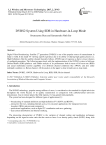
DVBS2 System Using SDR in Hardware-in-Loop Mode
Статья научная
Digital Video Broadcasting- Satellite 2nd generation (DVBS2) is one of the popular source of entertainment in today's world. It has made TV viewing superb experience due to its ability of sharing high quality picture (i.e. High Definition). But the satellite channel basically follows AWGN type of response as there is lesser chances of multipath generation. The following paper deals with the implementation of the DVBS2 system in Software Defined Radio (SDR) platform and further analysis of its performance both in terms of bit error rate (BER) and actual multimedia transfer capability over different channel conditions like AWGN, and also under multipath condition i.e. Rician channel. All the analysis in the paper is done in hardware-in-loop mode.
Бесплатно
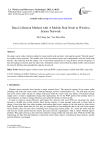
Data Collection Method with A Mobile Sink Node in Wireless Sensor Network
Статья научная
This paper resent a data collection method of using mobile sink and static sink together against “thermal region” in wireless sensor network. The mobile sink visits the remote-cluster and communicates with the head node directly, thus reducing both the energy cost of multi-hop transmission in long distance and the frequency of data forwarding in clusters near the static sink. Simulation results showed that the added mobile sink extended the network lifetime and expanded the capacity of network.
Бесплатно
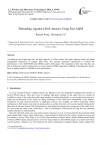
Defending Against LDoS Attacks Using Fair AQM
Статья научная
According to the instant high rate and high intensity of LDoS attacks, this paper explores using fair queue management mechanism to mitigate their effect. We perform simulation experiments to evaluate the performance of fair AQM FRED and CHOKe under LDoS attacks. The simulation results show that they are able to reduce the impact of the attacks in various degrees. FRED outperforms CHOKe in throttling the attacks, but it is slightly inferior to CHOKe in time performance.
Бесплатно
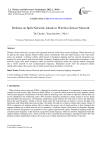
Defense on Split-Network Attack in Wireless Sensor Network
Статья научная
Wireless Sensor Network is an open self-organized network, which faces serious challenge. Whole network can be split up into many separate subnets which cannot communicate with each other because some vital sensor nodes are attacked. A defense scheme which based on frequency hopping and fast network integration was proposed to react against split-network attack. Frequency hopping makes the communication frequency of the network escape from attack frequency while fast network integration makes the separate subnets reintegrate into a whole network in new communication frequency. Simulation results show the proposed scheme significantly reduces the success rate of attack and increases the lifetime of network.
Бесплатно
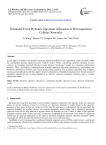
Demand-Driven Dynamic Spectrum Allocation in Heterogeneous Cellular Networks
Статья научная
In this paper, we address the dynamic spectrum allocation problem in next generation cellular networks under the coordinated dynamic spectrum access (CDSA) model. Firstly, considering spectrum demands of base stations, we formulate spectrum allocation under physical interference models as a nonlinear optimization problem. Then, we propose a demand-driven dynamic spectrum allocation algorithm by transforming this nonlinear optimization problem into linear programming problem. The proposed algorithm first computes initial spectrum allocation and then applies iterative enhancement. Detailed simulations show that the proposed algorithm outperforms the existing algorithms in effective spectrum utilization efficiency and in average satisfaction degree.
Бесплатно
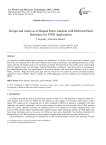
Design and Analysis of Biquad Patch Antenna with Different Hard Substrates for UWB Applications
Статья научная
An innovative double Biquad patch antenna was introduced. It consists of two quad patch together. good directivity was achieved due to the corner reflector effect used in this design. The radiating elements are of four square with the side length equal to 1/4 mid band wavelength. The theoretical beam width can be varied widely with the reflection plane size and shape. Vertical Polarization is achieved from the position of orientation of the biquad.Biquad patch was implemented in microstrip antenna with three hard substrates such as Arlon, Neltec, and Fr4, High directivity,good gain and low return loss was achieved, and the resonant frequency obtained is from 5-10GHz, which is suitable for UWB application and the simulation was performed using HFSS.
Бесплатно
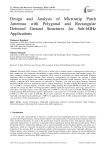
Статья научная
Microstrip Patch Antennas (MPAs) play a critical role in modern wireless communication systems due to their compact size, easy integration, and capability to ensure reliable communication across wide frequency ranges. This paper introduces enhanced designs of rectangular MPAs aimed at overcoming the narrow bandwidth limitation commonly found in traditional designs. Three innovative configurations are proposed: one featuring a simple rectangular slot on the ground plane, another integrating polygonal Defected Ground Structures (DGS), and a third utilizing rectangular DGS. These antennas are optimized at a frequency of 4 GHz using High Frequency Structural Simulator (HFSS) software to significantly improve antenna performance. The MPA without DGS showed a return loss of -21.124 dB at a resonant frequency of 4 GHz, with a Voltage Standing Wave Ratio(VSWR) of 4.8038 and a gain of 3.88 dBi. In contrast, the MPA with Polygonal DGS exhibited significant improvements, achieving a return loss of -26.87 dB at a resonant frequency of 4.1 GHz, along with a VSWR of 1.3721 and a gain of 4.38 dBi. Similarly, the MPA with Rectangular DGS demonstrated superior characteristics, with a return loss of -27.08 dB, resonance at 3.825 GHz, a VSWR of 1.4399, and a gain of 4.00 dBi. These results underscore the effectiveness of DGS in broadening the bandwidth and improving the performance of MPAs for applications below 6 GHz, making them highly suitable for next-generation wireless communication systems.
Бесплатно
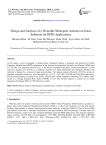
Design and Analysis of a Wearable Monopole Antenna on Jeans Substrate for RFID Applications
Статья научная
In this paper a novel rectangular C-shaped planar monopole antenna is designed and analyzed for Radio Frequency Identification (RFID) application in the licensed-free Industrial Scientific and Medical (ISM) band of 2.45 GHz. The proposed antenna uses a 1 mm thicker wearable Jeans fabric {relative permittivity, εr=1.68 and Loss Tangent of δ=0.025} as a substrate material. For better bandwidth, and radiation efficiency the substrate is backed by a truncated copper ground plane. The antenna operate efficiently (92.85%), giving an adequate bandwidth, return-loss, gain and directivity of 12 %, -35.57 dB, 3.144 dB and 3.465 dBi, respectively. The nominated antenna is compact, low profile, and provides a better impedance matching (50.25 ohms) which results in a Voltage Standing Wave Ratio (VSWR) of 1.03. The far-field analysis is carried out via Finite Integration Technique (FIT) in CST Microwave studio.
Бесплатно
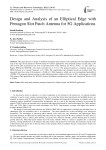
Design and Analysis of an Elliptical Edge with Pentagon Slot Patch Antenna for 5G Applications
Статья научная
This paper presents a design of modified rectangular patch antenna with a pentagon slot and elliptical-shaped strip at the edge of the antenna for Sub-6G band 5G wireless applications. The proposed antenna excited using a 50-ohm coaxial cable transmission line. The overall dimensions of the substrate are 49.72 x 43.02 x 1.7 mm3 used on a Rogers RTDuroid 5880(TM) with relative permittivity of ∈r=2.2. The proposed antenna is simulated using Ansys HFSS Software at a resonant frequency of 3.2 GHz. The experimental and simulated results are matched well. The measured return loss value of the antenna is -20 dB at 3.2 GHz frequency, which can cover an impedance bandwidth of 150MHz. The proposed antenna provides a stable radiation pattern, radiation efficiency is 96%, and peak gain is 4.6 dBi. This antenna finds applications for WiMAX wireless broadband communication, radar, and commercial Wireless LAN in S-band.
Бесплатно
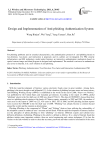
Design and Implementation of Anti-phishing Authentication System
Статья научная
For phishing problems and its essential characteristics, the authentication protocol of anti-phishing based on two-direction, two-factor, and interaction is proposed, and its safeties are investigated. For PKI security infrastructure and B/S technology model under Internet, an interactive authentication mechanism based on special custom image and client program is designed and implemented. The method is universal to authenticate any server on Internet. It is a new solution of anti-phishing.
Бесплатно

Design and Implementation of Management Information System of Field and Track Training
Статья научная
In terms of features of field and track athletes’ training, this paper, integrating techniques of network, database, computers, multi-media, image processing, etc, devises a management information system of field and track training based on B/S model and provides an training information processing system. This paper analyzes the systematic functional structure and the constitution of systematic sub-systems in detail. Meanwhile, it elaborates on the design of systematic functional structure, network structure, link modes and systematic soft wares’ functions, and introduces web, database and ASP dynamic homepage technique applied in the interactive Web system design, followed by the cases for illustration of some relevant designs.
Бесплатно
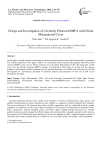
Design and Investigation of Circularly Polarized RMPA with Chiral Metamaterial Cover
Статья научная
In this paper, a simple method for designing a circular polarized antenna using chiral metamaterial is presented. The antenna proposed in this paper consists of conventional linear polarized Rectangular Microstrip Patch Antenna (RMPA) and cover of bilayer twisted cross wire Chiral Metamaterial (CM). The placement of CM cover over the linearly polarized RMPA changes its polarization from linear to circular and the antenna produces a left handed circularly polarized wave at resonant frequency of 6.24GHz with axial ratio of 0.46 dB. Investigation of performance parameter of proposed antenna and parameters of unit cell of CM is also presented in the paper.
Бесплатно
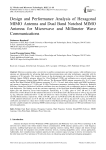
Статья научная
Microwave antennas play a crucial role in satellite communication and radar systems, while millimeter-wave antennas are indispensable for advancing high-speed telecommunications and radar technologies, especially with the emergence of 5G networks. This research focuses on the development and evaluation of two distinct Multiple Input Multiple Output (MIMO) antennas tailored for Ultra-Wideband (UWB) and millimeter-wave network applications using High Frequency Solution Setup (HFSS) software. The Hexagonal MIMO antenna, measuring 40 x 36 x 1.6 mm³, and the Dual Band Notched MIMO antenna, measuring 35 x 23 x 1.6 mm³, both utilize double-port MIMO technology and operate at frequencies of 7.5 GHz and 30 GHz. Performance parameters including Gain, Directivity, Radiation Efficiency, Return loss, Reflection Coefficient, and Beam Area are examined, with a comparative analysis conducted at both frequencies. The findings reveal the consistent superiority of the Dual Band Notched MIMO antenna, exhibiting higher gain and directivity across both frequencies. Specifically, at 7.5 GHz, gains of 24.97 dB and 33.17 dB, directivities of 6.05 dB and 5.10 dB, radiation efficiencies of 18.9 dB and 28.07 dB, beam areas of 4.94 sq. deg and 5.89 sq. deg, reflection coefficients below -12 dB, and return loss values exceeding 12 dB are observed for the Hexagonal and Dual Band antennas, respectively, while at 30 GHz, gains are 32.49 dB and 24.92 dB, directivities are 6.79 dB and 7.9 dB, radiation efficiencies are 16.41 dB and 24.57 dB, beam areas are 4.20 sq. deg and 3.07 sq. deg, and reflection coefficients and return loss values show similar trends for Dual Band and Hexagonal antennas, respectively. This study provides valuable insights for optimizing MIMO antenna designs to enhance performance in UWB and millimeter-wave network applications.
Бесплатно
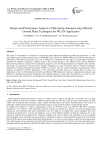
Статья научная
This paper is concentrated on comparison of rectangular patch antenna with different ground plane dimensions i.e. short edge, double ground, triple ground in terms of Bandwidth, Gain, Directivity, VSWR, Reflection coefficient and efficiency performance. The finite ground plane gives rise to diffraction of radiation from the edges of ground plane resulting in modifying of radiation conductance, radiation pattern, and resonant frequency. The substrate used is Flame Retardant-4epoxy having dielectric constant of 4.4 and dielectric tangent loss of 0.02. The patch antenna is provided by inset feed line. The design was optimized to obtain the most suitable configuration in terms of desired values of reflection coefficient, bandwidth and Voltage Standing Wave Ratio (VSWR) for antenna with and without modifying on ground plane. These antennas are suitable for WLAN Applications. In this observation, the paper calls for an attention that, the cachet is an amelioration of the 2.4 GHz Industrial, Scientific and Medical (ISM) Band patch antenna is simulated and analysed using HFSS 13.0 and fabricated by photo lithography. The proposed antenna is tested using VNA E5071C.As a result it can be also observed in being when the size of ground plane is increased, the ripples in the main pattern diminishes.
Бесплатно
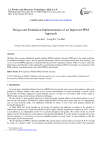
Design and Simulation Implementation of an Improved PPM Approach
Статья научная
Different from recent probabilistic packet marking (PPM) methods, Dynamic PPM may solve many problems of traditional methods, such as loss of marking information, hard to reconstruct attack path, low accuracy, and so on. A novel DPPM approach is proposed and the network simulation software (NS2) is used to verify the performance and efficiency of the approach by constructing simulation DOS environments. In comparison with PPM methods, simulation results show that DPPM is much better.
Бесплатно
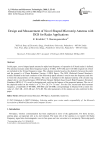
Design and measurement of novel shaped microstrip antenna with DGS for radar applications
Статья научная
In this paper, a novel shaped patch antenna for triple band frequency of operation in X-band (radar) is defined. The antenna resonates under three frequency bands at 10 GHz, 10.93 GHz and 11.68 GHz respectively which are included in the X-band frequency range. The substrate material used as the dielectric between the patch and the ground is of Flame Retardant Version 4 (FR4) Epoxy. The DGS (Defected Ground Structure), usually included in the back conductor of the Microstrip patch antenna is used to tune the frequency and also to boost the characteristics of the antenna. The same is included in this depicted antenna with circular ring shaped slot to vary the performance. FEM (Finite Element Method) based Ansoft High Frequency Structural Simulator (HFSS) V.12 is used for designing and verifying the features of the proposed antenna. The size of the depicted model on the whole is of 31.34 × 28.33 × 1.6 mm3. For the first, second and third resonant frequency, a bandwidth of 480 MHz, 600 MHz and 420 MHz correspondingly is obtained with a return loss value of -18.47 dB, -42.22 dB and -19.74 dB. The other parameters of the antenna are also conferred in this paper.
Бесплатно
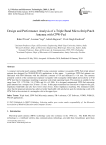
Design and performance analysis of a triple band micro-strip patch antenna with CPW-fed
Статья научная
A compact microstrip patch antenna (RMPA) using systematic coplanar waveguide (CPW-Fed) triple printed antenna has designed for WiMAX/WLAN applications in this paper. A prototype CPW-Fed antenna was fabricated with FR4 Substrate with the dielectric constant of 4.4 and thickness h =1.6 mm. The antenna primarily consists of the symmetrical coplanar waveguide with rectangular slotted patch and excite by a 50 Ω CPW feed line for impedance matching to generate wide triple operating bands. This antenna is suitable for the range from 2.39 -2.75 GHz, 3.4-3.7GHz and 4.6 -6.9 GHz. It is designed miniaturized CPW-Fed microstrip patch antenna has a compact size 20 mm x 35 mm. In this paper researcher has focused on to improve the gain, impedance bandwidth and also have lower return losses, better impedance matching. The simulated results show that the proposed antenna has achieved wider bandwidth with satisfactory gain by introducing a stub with CPW-Fed in the assistant of a rectangular slot in the upper layer.
Бесплатно
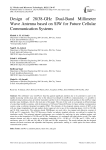
Статья научная
The millimeter wave (mmWave) band has gained significant attention due to its potential to cater to the rapidly increasing wireless data rates. Due to the reduced wavelength in mmWave communications, it is possible to implement large antenna arrays at both the transmitter and the receiver. Designing small antennas in the mmWave range presents many challenges, which is the main aim of this paper. The aim of this work is to proposed an efficient design of a dual-band mmWave antenna, with the dimension of 26.5mm×7.0mm×0.254mm, for future cellular communication systems using a substrate integrated waveguide (SIW). The elements of the proposed antenna consist of SIW cavity with one longer longitudinal slot and another shorter engraved slot in one of the conducting planes (1×2) for 28 GHz and 38 GHz, respectively. The substrate duroid 5880/Rogers are used with a loss tangent and dielectric constant of 0.003 and 2.2, respectively. The CST Microwave Studio, an industry-standard software, was utilized to conduct the simulation results. The proposed antenna's performance was evaluated by analyzing its gain, radiation pattern, and return loss at the frequencies of 28 GHz and 38 GHz. Furthermore, it is compared with other relative works. The single antenna element was able to attain an impedance bandwidth (S11< -10 dB) of 1.32 GHz and 3.1 GHz, with a satisfactory gain of 6.1 dBi and 5.81 dBi at 28 GHz and 38 GHz, respectively. The results indicate that the designed antenna can attain consistent and adjustable dual-frequency performance, making it a viable option for future cellular communication systems.
Бесплатно
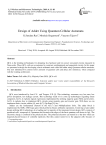
Design of Adder Using Quantum Cellular Automata
Статья научная
QCA is the trending technologies for designing less hardware and low power consumed circuits measured in Nano-scale. These QCA cells are accustomed to construct combinational and sequential circuits. In this paper we presented a design for developing a basic arithmetic unit called full adder using Quantum cellular automata. The new submitted FA consists fewer amounts of quantum cells and delay also minimizes, when compared with the existing architecture.
Бесплатно
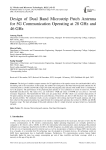
Design of Dual Band Microstrip Patch Antenna for 5G Communication Operating at 28 GHz and 46 GHz
Статья научная
The design of suitable compact antenna for 5G applications with superior return loss and bandwidth is still a fascinating task to the researchers. In this paper, the authors have designed a dual band microstrip patch antenna for 5G communications at 28 GHz and 46 GHz using CST studio. Rectangular patch antenna with double slots is considered to serve the purpose. The performance of the proposed patch antenna is very satisfactory in terms of return loss, VSWR, bandwidth and directivity. The values of S11 are well below -39dB and values of VSWR are very close to 1 for both resonance frequencies. The bandwidths for both cases are greater than 1.8 GHz which is an essential characteristic of 5G patch antennas for high speed connectivity and efficiency. Directivities are above 6 dB which are very suitable for the present problem. The simulation results are also compared with existing dual band 5G patch antennas and it has been observed that proposed antenna has outperformed the existing patch antennas that worked in 28GHz and 46GHz frequency range. The main advantage of this patch antenna is that it’s simple structure and good return loss, bandwidth and gain.
Бесплатно

